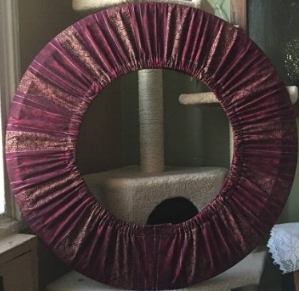10 Ways to Improve Your Hooping and Other Flow Arts!
1. Stretch
Stretching is extremely important to reaching your potential. It increases your range of motion enabling you to do many more tricks with greater ease. It helps to clean up planes, improves your posture and protects you from injury. Not to mention, it allows you to attain some very beautiful poses like the ones linked below.
Romina Micheletty Lisa Lottie
2. Explore other props
Do not just be a one-prop stop. The more props that you use, the higher your learning curve will be. All of the flow arts synergize to create a well-rounded flow with a more comprehensive understanding of the technical breakdown of all flow arts. Have you hit a plateau? Try a new prop. It will get you to think outside the groove that you may have become accustomed to. The translatability of the different flow arts allows you to transfer the new movements you have just picked up back to your old prop. Suddenly you will level up! Often igniting a renewed passion for that prop and the flow arts in general. The more props you use, the easier it becomes to learn a new one. You often skip the beginner’s stage entirely. All props are related. Branch out; you’ll thank me later. Here are some props to explore: Poi, 8 Rings, Contact Balls, Staff, Dragon Staff, Buugeng, Fans, Clubs, Devil Sticks
3. Utilize complementary practices
Similar to the synergy created by using multiple props, having other complementary practices can enhance your progress in the flow arts. For instance, dance, yoga and meditation can help improve your body control, fluidity and focus. Often after a good yoga session or a deep meditation, you will find it much easier to get into and stay in the flow state. Your muscles are warmed up and your mind is clear of distractions.
I highly recommend trying an isolation tank, also known as, floatation tanks or sensory deprivation chambers, and seeing how it facilitates the flow state and enhances your creativity. Isolation tanks are basically large enclosed bathtubs that are filled with extremely dense saltwater that automatically makes you float and feel weightless. The water is the same temperature as your skin so your body loses awareness of its presence. Additionally, it is pitch black and completely silent so your brain does not receive any sensory stimulus. This allows you to enter into a deep meditative and relaxing state. You may find that afterwards, you will have a boost in creativity and you will immediately enter the flow state when you pick up your prop. Tricks that may have been eluding you for a long time, suddenly become trouble-free.
4. Drill
Another way to easily access the flow state, and in turn make progress, is to drill. Sometimes drilling even simple things such as spinning the hoop around your hand in different points in space for a minute or two can tighten up your planes tremendously and initiate a flow state. When a trick feels sloppy, drilling is how you clean it up! When you’re having an off day and you keep flinging your hoop, try some drills and then go back to your free flow. I guarantee you will feel an improvement. The muscle memory you get from drilling will help to keep your movements clean and smooth. Precise planes are how illusions are created and your transitions look and feel effortless. I recommend taking the first 10 minutes of each practice to drill and see how much more you get out of every session.
5. Find Balance
Balance is extremely important to your progression and life in general. If you only hoop or spin in one direction, you will be restricting yourself from many tricks such as fountains and 360’s. Your flow will be missing symmetry, which could even build up uneven musculature and can potentially be harmful to the health of your back. It is very important to do all tricks in both forwards and reverse. Anything that can be done forwards can be reversed. Once you learn both directions, anything can be done while turning in 360s. One way of learning reverse of any trick is to stall and try and do the exact motion you were doing backwards. Also you can play a video in reverse to get a visual understanding of what you are trying to do.
6. Watch others
Another hugely beneficial thing to do is to watch other hoopers or flow artists for inspiration. The online community has allowed us to freely exchange creative concepts and in turn the collective skill level of the flow community has exponentially increased. Don’t be afraid to incorporate different qualities that you admire in other flow artists into your own expression. We are the sum of our experiences. You are still uniquely you as you combine different aspects of different styles into your own. It is okay to borrow ideas from other artists. That is how we all grow. Just because someone may have a signature trick that associated with them, does not mean it is off limits to you or that you are an imposter by using it. Different tricks and concepts are no one’s to claim. If you do not take the time to watch others, you will miss out on loads of inspiration.
7. Watch yourself
Watching others can really boost your progress but watching yourself may be even more beneficial. A mirror or your shadow is a great tool for immediate visual feedback on what you are doing. It can help you to iron out mistakes, clean up tricks and remind you to work on the dreaded flow face. Watching yourself from a 3rd party perspective can greatly improve your understanding and solidify neural pathways enhancing coordination. Additionally, it may help you focus on the little things like pointing your toes and pretty hand movements that really give your flow the final oomph.
Another way to watch yourself is to watch videos. This allows you to see whether you are moving correctly without becoming too reliant on immediate visual feedback. I recommend recording as much of your practice as possible. Not only will it help you improve, but it will also help you to get used to videotaping yourself and you can overcome camera shyness.
8. Watch tutorials
I have encountered numerous individuals who have stated that they do not ever watch tutorials and are entirely self-taught. While that is notable, I think it is unwise if you are trying to progress swiftly. Often tutorials help to break down moves in ways that you may have not yet thought of. I suggest even watching tutorials at night before bed without attempting them. Since most of your progress actually occurs during sleep, it gives your brain the chance to process the information. Then you may find yourself able to do the trick the next day without much difficulty.
Some tutorials that should be apart of every flow artist’s arsenal include:
Drex Factor’s explanation of the Vulcan Tech Gospel: http://www.drexfactor.com/weirdscience/2015/11/25/vulcan_tech_gospel_vtg_explained
Home of Poi’s Learning Section including sections for all flow arts
http://www.homeofpoi.com/us/lessons_all/teach/
Hoop Tutorials
http://www.hoop-trix.com
9. Use variety
Variety is the spice of life. Similar to varying the directions of your spinning to achieve balance and using a variety of different props to achieve well-roundedness, there are other ways to vary your practice that will do the same. Some things that you should change up include the speed, timing, dimension and level of your spinning and the number, size and weight of your props. These things will help to make your flow more dynamic. You should also vary the type of music you listen to during your practice. Certain genres can help to facilitate certain styles of spinning. For instance, Liquid Dubstep or Chillstep is great for slow flow while Hardstyle is perfect for fast breaks. Likewise, practicing without music can also help you to find the natural rhythms of the movement itself.
10. Face-to-face skill exchange
Lastly, one of the greatest things you can do to aid your progress is to participate in face-to-face skill exchange. This can be as simple as having flow sessions with other flow friends in your area. Or you may want to travel to a flow festival. Flow festivals can help you to make intense leaps and bounds in your practice. They usually consist of a weekend of intensive training with exposure to the latest and greatest techniques. Not to mention you are able to receive personalized feedback on where you may be going wrong while learning a new trick. This allows you to learn many more tricks or concepts in a time period than if you were trying to learn from a tutorial or on your own.
We hope that these tips can help take your practice to the next level! Let us know in the comments any tips you may have that we didn’t mention and share this with any friends that you think could benefit. ☺
Written by: Crystal Smith













